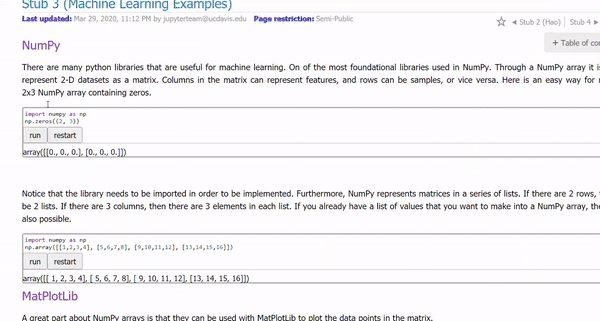- Mon 22 June 2020
- education
- Hao Huang, Tannavee Kumar, Celine Liang
- #oer, #education, #jupyter, #textbooks, #engineering, #libretexts
Background
During the end of the Fall Quarter 2019 and Winter Quarter 2020, we focused on building a CKEditor Binder Plugin to be used on the LibreTexts website to allow textbook authors to insert executable code blocks. We intend for both textbook authors and readers to have the ability to edit and run code blocks efficiently, making online educational content more interactive.
Build Process
We started the project by surveying LibreTexts authors and readers on their most requested features.
BinderHub
On the backend, the CKEditor Binder plugin utilizes a project called BinderHub to run code blocks. BinderHub is developed as part of the Jupyter project and gives custom computing environments based on a list of requirements specified through a GitHub repository.
Thebelab
Thebelab and Juniper are two examples of projects which can insert code blocks into HTML pages and running them by requesting a kernel from a computing backend like BinderHub. We found that Juniper had some better deign elements; however, Thebelab was more actively maintained. We deliberated on which project to incorporate into our plugin, and decided to use Thebelab since the recent commits indicated that any possible need for help would be more promptly met. To incorporate some of the streamlined design elements of Juniper, we planned on adding syntax highlighting.
Creating the plugin
Our plugin is based on the CKEditor 4, an open source “what you see is what you get” text editor. This is the editor authors use on the LibreTexts website.
Our approach to this plugin is to make use of a widget, on the editor which allows us to place all the HTML elements of Thebelab together as one unit. In other words the widget is a component made out of multiple separate elements that are grouped together for easy formatting and movement; however, individual parts can be altered independently. This allows for the CKEditor instance to easily enforce the elements. Additionally, we created a dialog window for each code block so that users can modify each block whenever they want.
Mindtouch Specific Settings
One of the challenges we faced was working around Mindtouch, which sometimes caused the plugin to function in unexpected ways. For reference, Mindtouch is the web based wiki software that Libretexts uses and it uses a CKEditor. An example of an obstacle we faced was that Mindtouch seemed to apply its own CSS to the plugin. This caused text overflow, addition of characters to the end of each line, etc. In order to resolve this, we added our own styling to the plugin. If one wishes to use the CKEditor plugin on their own pages, they can remove the extra styling in the folder.
Another difference was JavaScript conflict. When we were trying to support Jupyter Widgets, we found that it depended on Require.js. However, adding Require.js to Mindtouch would break all the JQuery plugins. In order to fix all the JavaScript conflicts, we created registerPlugin.js to include all Mindtouch specific JavaScript code.
Including different programming languages
During development, we used environments developed by the Jupyter project. Using their Binder environments helped us test and include different languages in our editor. Eventually we will utilize, we would utilize the same default environment in our JupyterHub for our editor. This default environment contains many packages that are commonly used and requested by students and faculty.
Github Actions
We made use of Github Actions to automate two important tasks. After each push on Github, it will trigger our custom linter to ensure code quality and consistency. Additionally, if we push any code to the master branch, it will trigger an automatic deploy to production.
CKEditor Capabilities
Currently authors publishing on the LibreTexts platform have the option to insert executable code blocks using Octave, SageMath, Julia, R, Python, and C++. There is a possibility that other languages may be added in the future. Authors can choose to either copy and paste their code into the text editor, or directly code in the text editor as they would any other one. To ensure that it is easy for the author as well as the reader of the textbook to view the contents within the code block, as described in the aforementioned section, syntax highlighting is made available via CodeMirror for all the languages except SageMath which is not supported by CodeMirror.
It is important to note that we suggest authors run the sample Hello World print statement first to get the kernel started, once that is successful, code can be added in the dialog box. For C++, if the code has already been run, but the author wants to make any changes, they will need to restart the kernel in order to avoid an Interpreter Error as any variables will be assigned more than once in Binder which is not allowed in C++.
Packages and libraries can be exported as they normally would; however, if an author finds that a specific package or library that they would like to use is not currently available they can make a request to have it added by either sending an email to the Jupyter Team, linked in the dialog box, or open an issue .
Once the author is ready to insert the code block into their textbook page, they have the option to either 'Insert with code and output,' 'Insert with code only,' or 'Insert with output only.' Selection of any of these choices depends on how the author intends to communicate the information provided in the code block. If the code block has already been inserted into the page, and the author wants to make any changes, they can simply double click on that section and the dialog box will pop back up.

Figure 1: Example of what and author can do with CKEditor, and what the output will look like
Future
As mentioned before, a long term goal is to use default-env for the packages, this is the same environment that is used for the LIbreTexts-UCD JupyterHub, and by
using this, authors will have a greater selection of packages and libraries to choose from, and it will also be easier for us to maintain. We also want to improve the execution time of the code blocks, as currently requesting a kernel involves downloading an image from DockerHub and creating a Docker container.

